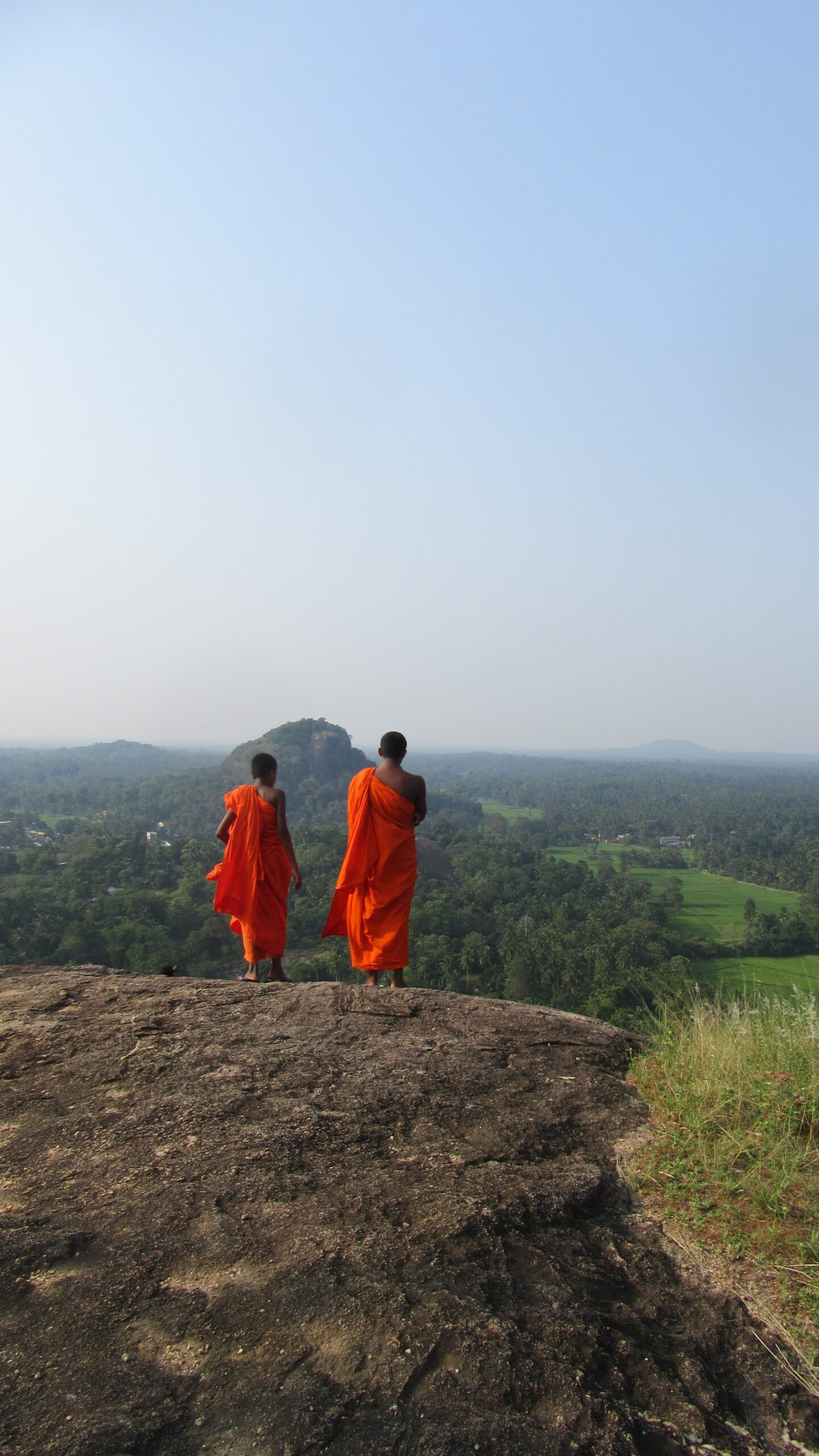How to Be a Noble Friend
Photo by by K. P. D. Madhuka.
Not only did the Buddha teach that we need good friends along the spiritual path, the heart of Buddhist practice gives us the tools and concrete guidance on how to be that resource for others. This talk draws on teachings from Theravada, Mahayana, and Vajrayana Buddhism, including a couple of the Pali Canon’s sutras, as well as the "Prajnaparamita in 8,000 lines."
This talk was given by Zuisei Goddard. See below for transcript.
Transcript
This transcript is based on Zuisei's talk notes and may differ slightly from the final talk.
“There is a type of suffering that, for most of us, is like an eyelash on the back of your hand, barely noticeable.” So said a good friend of mine—a noble friend or kalanyamitra—and fellow teacher. “But,” she continued, “for a bodhisattva, that eyelash is in their eye, it’s constant, and it’s excruciating, and they’ll do anything to extirpate it.” We’d arrived at this eyelash via an exploration of the three types of suffering the Buddha described:
the suffering of suffering; (dukkha dukkha)
the suffering of change; (viparinama dukkha)
and all-pervasive suffering. (sankhara dukkha)
The "suffering of suffering" is obvious suffering. It is the loss of a partner, or a job, aging, illness, death, physical pain, emotional pain. It is known suffering and we all see it and feel it. The "suffering of change" is a bit more hidden, if you will, in pleasant experiences. It’s in the delicious taste of a chocolate chip cookie that does not last, in the end of that wonderful vacation, in the fading of love or pleasure. This type of suffering is harder to recognize—Why are you spoiling my joy? It simply comes from the fact that everything that is conditioned is impermanent. Everything that depends on something else, by definition, cannot last when those dependencies change. So, no matter how much I enjoy my cookie as I’m eating it, my pleasure depends on the cookie and on the fact that I can taste it. When the cookie’s gone, my pleasure’s gone, it’s dependent and therefore, transient. That’s how change is suffering.
And finally, there’s "all-pervasive suffering," which is hard to recognize for most of us. Not to feel, we all feel it, but to be able to recognize and name it? Not so much. I’ve spoken of this type of suffering as a shimmering, as this low thrum under everything that gives me the constant feeling that something is off. When I was younger, I would feel it especially as the sun was going down. In the light of day, I was able to keep the feeling at bay, but dusk always made me feel restless and, if I’m honest, a bit scared—not scared at anything in particular, scared at being. I eventually was able to see. I would look around and think, Are people really happy with this? With life, with things? I’m not, so what’s wrong with me? What’s wrong with me? It took a while, but eventually I came across a path that assured me, very plainly and directly, that there was nothing wrong with me, that I wasn’t broken. I was, and am, a living being, and so I suffer. But, the Buddha said, it doesn’t have to be that way. You don’t have to live with an eyelash in your eye. You don’t have to be in pain all the time. You don’t have to walk around, half-blinded.
First, realize you have an eyelash in your eye. It doesn’t matter how many vacations you take, how many sumptuous meals you have, how many titles or memories you accumulate, the eyelash will still be there. You need to focus on getting it out. When we look at it this way, it makes sense, doesn’t it? When the Buddhist teachings say that pleasure, or possessions, or praise, or fame, won’t make us happy, they’re not saying, Don’t enjoy yourself.They’re simply saying, Watch, because it won’t last. Yet there is something that lasts, something enduring, and to look for it, you don’t have to go far.
Again: first, notice the eyelash, it hurts!; two, vow to do anything in your power to get it out; three, get to the point where you see there’s no eyelash, no eye. These are the teachings of the Prajna Paramita literature:
A Bodhisattva does not stand in form, perception or in feeling,
In will or consciousness, in any skandhas whatsoever.
In Dharma’s true nature alone she is standing.
Then that is her practice of wisdom, the highest perfection.
Four, don’t stay there. (The sutra says, “You can’t stand on emptiness.”) So, five, recognize that the eye, and your whole being, is resplendent. It is luminous, it is loving, it is unfailingly kind, it is wise beyond measure. All of that you couldn’t see is because you had this tiny bit of hair in your eye. Maybe it takes a little pain for us to realize, Oh, I’m so much more than my complaints, my opinions, my secret grudges. I’m so much more than my pain, my longing. I’m so much more vast, so much more inconceivable. This is what the Vajrayana expresses so well.
Every time I speak to my friend I am fired up anew about the dharma. It’s the best gift she could give me. Let me take a moment here to speak of kalyanamitra, a noble friend. When someone asked the Buddha what was admirable or noble friendship, he said that it’s when a layperson spends time with other laypeople who are “advanced in virtue.” People who are wise and generous and honest and “have conviction.” Maybe a way of saying that is that they know who they are, they are grounded in their own being, so they can share some of that ground with you when you need it. He also says that a friend worth cultivating has seven qualities: they give what is beautiful; they give what is hard to give; they do what is hard to do; they endure painful or ill-spoken words; they tell you their secrets, and keep yours; they don’t abandon you when you’re low or look down on you.
A person in whom these traits are found, the Buddha says, is a friend to be cultivated by anyone wanting a friend. A good friend will provide this kind of support. A noble friend will steer you in the direction of the dharma, not necessarily by preaching, unless that’s appropriate, but by their actions, their words, their demeanor. They might help you to see what that thing is in your eye, blurring your vision. Maybe they’ll reach over, and ever so gently blow the eyelash out. Maybe they’ll do it without knowing they’re doing it at all. (I’m fairly certain he has no idea what he gave me. Without speaking a single word, without even looking at me, he just sat there quietly and ate his dinner, and inside me, everything changed.)
To me, a truly good friend is able to endure, or at least tolerate, my discomfort or sadness or pain. I appreciate when a friend says to me, “Oh, that must be so painful,” or “I'm sorry you're going through this difficult time.” I prefer this to, “It’s okay. You're going to be okay.” I’d rather they don't rush to comfort or reassure me. I’d rather they have the courage and the strength to be with what is just as it is. That, I find, is the true comfort.
When asked about the necessary conditions for awakening, the Buddha answered: “Having admirable people as friends, companions, and colleagues. This is the first prerequisite for the development of the wings to self-awakening.” Isn’t that interesting? He didn’t say, sitting in seclusion, living by clear ethical principles, developing strong concentration. He said, “Having admirable people as friends, companions, and colleagues ...” The Buddha, who was left by his friends when he stopped the ascetic practices that almost killed him, who left the teachers behind whom he knew had taught him all they could teach him, who was alone when he realized himself, though not really, he said the first thing you need to awaken is to have good people around you. Isn’t that wonderful?
In a story I once read, a friend follows another into Central Park. They walk through the Ramble. Do you know it? A wild place in the center of a place wilder still, resplendent and emerald, especially in the early summer sun. One friend steps over a little metal fence into a thicket to stand in front of a tree whose branches ducked and curled around the others in search of the light.
“What do you think?” she asks her friend, who’s frankly nonplussed.
What do I think of what? is in her friend's mind. Just a tree.
This friend thinks in generalizations, abstractions, while the first lives in what is tangible and fine: favorite brick on the facade of an old apartment building—the one to the right of the door, covered in lichen; a favorite letter of the alphabet, “g,” but only in lowercase, and only in Times font; a favorite aisle in the supermarket, the one with sauces and pickled ham. Every morning, a text:
“Have you noticed the clouds?”
“Along the highway, a sign that says ‘ROMEO: Retired Old Men Eating Out.’”
“How are the wings?” The two always joked they were angels in disguise.
The first friend is astonished constantly. It’s like she can’t get enough for life. When she dies early, unexpectedly, the second friend begins to notice things she never noticed before. How the belly of the “g” is like a spring, coiled to keep the head of the letter up. The tone of voice of a woman talking to her friend, “But I’m not like that,” which tells her she’s exactly like that. The way a grasshopper sits with its hind legs elevated when you get close, ready at the slightest sign of threat to fly off. She noticed all these things and so many others she’d never seen, slowly filling her life with the real. Sometimes she even forgets her friend is no longer there. Sometimes she sees her in a piece of moss, in a ray of slanting afternoon light, in the memory of her friend’s favorite phrase, “Will you look at that!”
This is from The Connected Discourses:
What is the friend of one on a journey?
What is the friend in one’s own home?
What is the friend of one in need?
What is the friend in the future life?
A caravan is the friend of one on a journey;
A parent is the friend in one’s own home;
A colleague when the need arises
Is one’s friend again and again.
The deeds of merit one has done—
That is the friend in the future life.”
A caravan, a parent, a colleague, and merit, I love this reference to merit as a friend. This week I wrote that a practitioner, one who has turned toward the Dharma, has four qualities—they listen, destroy, endure, and go fast—and these qualities cause them to be a field of merit for the world.
Merit or punya is a protective force, and it accumulates as we do good deeds, which include thoughts and words. I think of merit as good that attracts good, that propitiates good. Therefore, to be a field of merit for the world, we have to listen, destroy, endure, and go fast. A practitioner listens when they pay attention to, engage wholeheartedly, and take heed of the Buddha's teaching. “Heedfulness” is such a great word, and it’s often used in Buddhism.
Let me respectfully remind you,
Life and death are of supreme importance.
Time swiftly passes by, and opportunity is lost.
Each of us must strive to awaken.
Awaken … take heed! Do not squander your life.
This is the Evening Gatha, chanted in Zen monasteries at the end of the day. “Take heed,” it says. Pay attention. Don’t let life pass you by. This is how we listen to the dharma, with a sense of urgency and the determination to bring it into our lives.
A practitioner destroys any thought that is malicious, that is cruel, or that in some way obscures their inherent clarity of mind. Not only that; a practitioner “obliterates” any unskillful qualities, giving them up for the sake of liberation. There’s a time to be gentle and loving, there’s a time to say, “Enough!” Sometimes, the only thing to do with a poisonous thought, for example, is to cut it at the root before it has a chance to bloom. A practitioner endures physical pain and discomfort, heat and cold, the threat of insects and reptiles, as well as “rude and unwelcome criticism.” In other words, they aren't swayed from their meditation.
I think of Mara saying to the Buddha on the eve of his enlightenment, And who do you think you are to become enlightened? No one has ever done this before. What makes you think that you can? Calmly, the Buddha touches the earth, asking it to be his witness, and says to Mara, “I know you.” I know you. I know you, doubt. I know you, self loathing. I know you, relentless self criticism, and I will not let you win.
Finally, a practitioner goes fast by going where they've never gone before. They still their body and their mind; they let go of grasping; they put an end to the craving that keeps them trapped in an endless loop of pleasure and pain (viparinama dukkha); and they realize cessation. We’re “going fast” now in the direction of our own freedom, of liberation even though getting there may not feel fast at all. But we are going where we haven’t gone before. We’re letting go of unskillful thoughts, we’re wondering whether to believe everything that we think, right? Are you doing that? We’re looking at how we get caught between pleasure and pain. We’re vowing to be good to ourselves and one another. Let me repeat that: We’re vowing to be good to ourselves and one another.
Heedfulness, determination, stamina, courage. All of these and more are needed to become the person we've always been—a noble friend, an admirable friend, and a supreme field of merit for the world.
Explore further
01 : Endure and Go Fast by Vanessa Zuisei Goddard
02: Mitta Sutta translated by Thanissaro
03 :Naga Sutta: The Bull Elephant translated by John D. Ireland
04 : The Perfection of Wisdom in Eight Thousand Lines translated by Edward Conze


